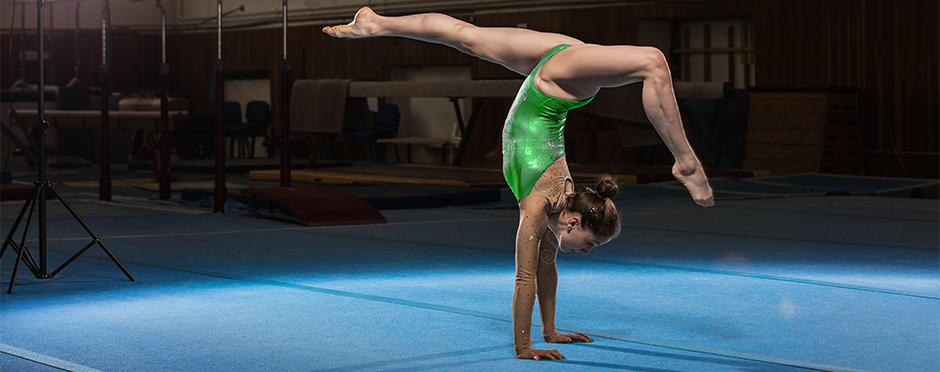
Should Gymnasts Lift Weights?
Leave a CommentGymnasts are strong, and they have to be to do their amazing tumbling passes, hang and spin on the bars, and perform their routines on beam or pommel horse. Weight lifting is a common way that many athletes build strength. However, in the gymnastics world, weight lifting has mixed reactions. Historically, many gymnastic coaches and athletes have discouraged weight lifting routines as they may “bulk” up the athlete. Gymnasts need to maintain certain agility and flexibility to perform their skills and be able to fly through the air. The question becomes, “can a gymnast lift weights for strengthening purposes without causing harm?”
The Concerns:
Heavy weights for strengthening have been shown to lead to muscle hypertrophy. Muscle hypertrophy is the growth of new muscle fibers, which can make the overall muscle bigger. Hypertrophy increases the strength of a muscle and its ability to withstand greater loads1. Hypertrophy has also been shown to possibly protect against soreness and potentially decrease injury risk2. Gymnasts need to have great strength throughout their upper and lower body, as well as their core abdominal muscles, to perform their skills. It has been shown that during tumbling, gymnasts can experience up to 16 times their body weight across the wrist joint3. Therefore, gymnasts need a good strengthening routine to progress, advance their skill set, and possibly prevent injury.
Bigger muscles can sometimes be less flexible. Gymnasts need a lot of flexibility to perform their skills and tumbling. Historically, these conflicting thoughts prevented many gymnasts and coaches from using weights in strengthening programs; they did not want to sacrifice flexibility to build more strength. Instead, gymnasts would focus on body weight resistance exercises such as push-ups, squats, pull-ups, or lunges to build strength. Body weight resistance training can still have strengthening gains. Furthermore, many body weight exercises can support functional strengthening for gymnasts; examples of functional strengthening include squat jumps or box jumps which can help with the power and speed needed for specific gymnastic events.
Maintaining flexibility when building muscle strength includes performing resistance training through the full range of motion. For example, squatting to a full-depth position instead of stopping near 90 degrees. It is also important to have a good stretching routine, both a warm-up prior to weight lifting and a cool-down stretching routine for flexibility after weight lifting. By focusing on these items, you can maintain or gain flexibility while gaining strength.
Another consideration is weight training can include something other than maximal resistance. Weight training can focus on lower loads with higher repetitions to build strength. Weight training, especially for gymnasts, may allow them to build strength in a way that places less stress across the joints compared to repetitive functional skills training. Furthermore, if an athlete is only uses body weight resistance for strengthening, how are they preparing for up to 16 times body weight resistance experienced during some skills? Weight training can strengthen the athlete to prepare for these higher forces and can also be used to enhance an athlete’s power.
Summary:
- Gymnasts need a strengthening program.
- Proper form and training are needed for safety during weight training.
- Weight training does NOT automatically lead to a decrease in flexibility.
- Use weight training to teach gymnast control and coordination that can transfer to skill work.
- Weight training can slowly expose the gymnast to new stress and loads, which will then help them with tumbling, dismount landings, and high-force upper body impact skills.
Athletico provides rehabilitation services to gymnasts and cheerleaders at all levels and abilities. We aim to evaluate, treat, and educate athletes preventing practice and competition-related injuries. Technical evaluations can be performed to improve postural awareness and maximize the function of each athlete. We have physical therapists and athletic trainers, including former gymnasts and cheerleaders at the high school, collegiate, and Olympic levels, involved with our Gymnastics and Cheerleading Program. Our clinicians understand the demands of the sport and use their personal and professional experience to address each athlete’s physical and psychological needs effectively. For more information, contact a Gymnastics and Cheerleading Rehabilitation Clinician by emailing GymCheer@athletico.com or clicking the button below.
Find a Gym/Cheer Specialist Near You
The Athletico blog is an educational resource written by Athletico employees. Athletico bloggers are licensed professionals who abide by the code of ethics outlined by their respective professional associations. The content published in blog posts represents the opinion of the individual author based on their expertise and experience. The content provided in this blog is for informational purposes only, does not constitute medical advice and should not be relied on for making personal health decisions.
References:
1. Russell B, Motlagh D, Ashley WW. Form follows function: how muscle shape is regulated by work. J Appl Physiol (1985). 2000 Mar;88(3):1127-32. doi: 10.1152/jappl.2000.88.3.1127. PMID: 10710412.
2. Suchomel TJ, Nimphius S, Stone MH. The Importance of Muscular Strength in Athletic Performance. Sports Med. 2016 Oct;46(10):1419-49. doi: 10.1007/s40279-016-0486-0. PMID: 26838985.
3. Webb BG, Rettig LA (2008) Gymnastic wrist injuries. Curr Sports Med Rep 7:289–295
